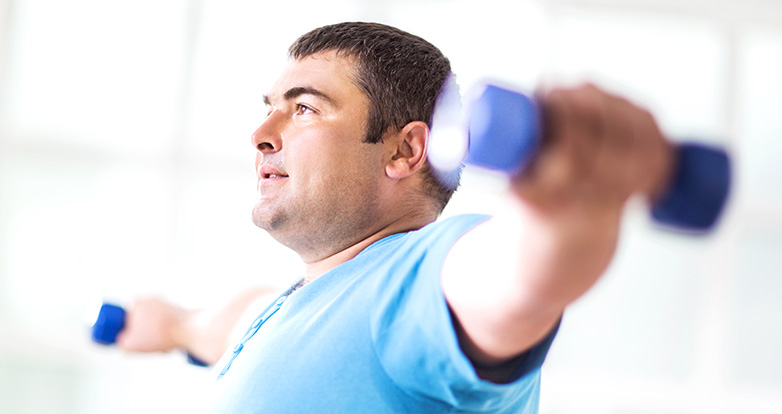Exercise and COPD: five simple steps to getting started
COPD | 11/15/2023
If you are already doing exercise to help manage your COPD, continue finding new ways to enjoy this by trying different activities or approaches, such as choosing new places to walk or attending a gym class. If you are about to start, these five simple movements will help you feel more confident in approaching regular exercise at a pace that suits you. The movements are designed to suit anyone, as they can be completed in the middle of daily activities, either as your whole exercise regime or in addition to your current routine. If you don’t enjoy working out alone, try some of these movements with your family and friends. By building exercise into your daily life, you can breathe easier and ultimately begin to feel better and stronger in the face of your COPD.
Exercise one: pursed-lips breathing
1. Sit down in a chair and relax your body.
2. Breathe in through your nose for two seconds.
3. Purse your lips (in a whistle shape) and breathe out for four seconds.
Pursed-lips breathing is an exercise designed to help you gain greater control over your breathing. To make your exercise efforts as easy as possible, you should begin by practising pursed-lips breathing on its own until it feels natural. You can then combine it with the other exercises in this article or try it during your daily activities that you currently find physically demanding.
Exercise two: small pauses
1. When rising from a seated position, stop and pause halfway through your rise.
2. Try to stay still and strong during your pause.
3. Try to add one second to your pause each time you do it, before continuing to a standing position. This exercise can also be completed when sitting down.
The small pauses exercise is a great way to add exercise into your daily life as you can challenge yourself to do it every time you sit down or get up. By starting with a small pause and building up slowly, you will be able to see how much progress you can make in a short period of time.
Exercise three: leg raises
1. Start by standing still, raise one bent leg to a height that feels comfortable.
2. Use your standing leg or a surface to keep your balance and hold your body in this position for a few seconds.
3. Return to a standing position and repeat on the other leg.
Pairing exercises with daily habits you already have is an easy way to remember to complete your exercises. The leg raises exercise can be completed anywhere, so is a good one to tie into activities like waiting for the kettle to boil or brushing your teeth. Try and add one second onto your leg raises each day.
Exercise four: opening the chest
1. Sit on a chair with your feet flat on the floor and rest your hands on your knees.
2. Curve your back forwards (like a cat) by rounding your shoulder blades, dropping your head and pushing back your chest.
3. Reverse the movement by arching your back and lifting your head towards the ceiling as if you want to look at it.
4. Move your shoulders back until you feel your shoulder blades coming together and puff out your chest.
Practice these movements at your own pace and rhythm. You can use your pursed-lips breathing during this exercise to support the opening and mobilisation of your chest. With exercises like this, it can help to lean on your support system, whether it’s a friend, colleague or family member. They can support by watching and helping you achieve the right position, as well as acting as a secondary reminder to complete your exercises each day.
Exercise five: upper body resistance
1. Imagine you have a piece of paper in the space between your upper arm and your side. If you release any tension, the paper will fly away.
2. Keeping the tension in your upper arms tight, stick your forearms out in front of you so your arms are sitting at a 90° angle.
3. Keep your elbows and upper arms touching the sides of your upper body. Open your bent forearms out to the side, before returning them to the start position.
With exercises like this, it’s good to start small and add a little every day. Tracking your progress in a diary can be motivational as you can see how far you’ve come. Adding two repetitions a day might not seem like a huge step on a daily basis, but over time that will build up. Remind yourself that consistent effort is the most important thing.
Trust the process
While it can feel frustrating to know you’re doing all the right things but still finding everyday tasks challenging, it’s important to remember that progress won’t happen overnight. Trust in the process and get started with these five simple exercises on a daily basis and you will soon feel the benefits and take control of your COPD.

Allow yourself to be creative - find new ways to incorporate these exercises into your daily routines and share your wisdom with others. Play your favourite song and move your arms to the beat or use pursed-lip breathing while watching the news. While you’re out walking try pausing on a single leg, whenever possible. Your life offers so many opportunities to help your body cope better with COPD.
- Dr Jutta Beier
September 2023 / CORP-RESP-1615
Orion Corporation is a globally operating Finnish pharmaceutical company. We develop, manufacture and market human and veterinary pharmaceuticals and active pharmaceutical ingredients. The dry powder inhaler developed at Orion is in the core of our respiratory therapy area.




